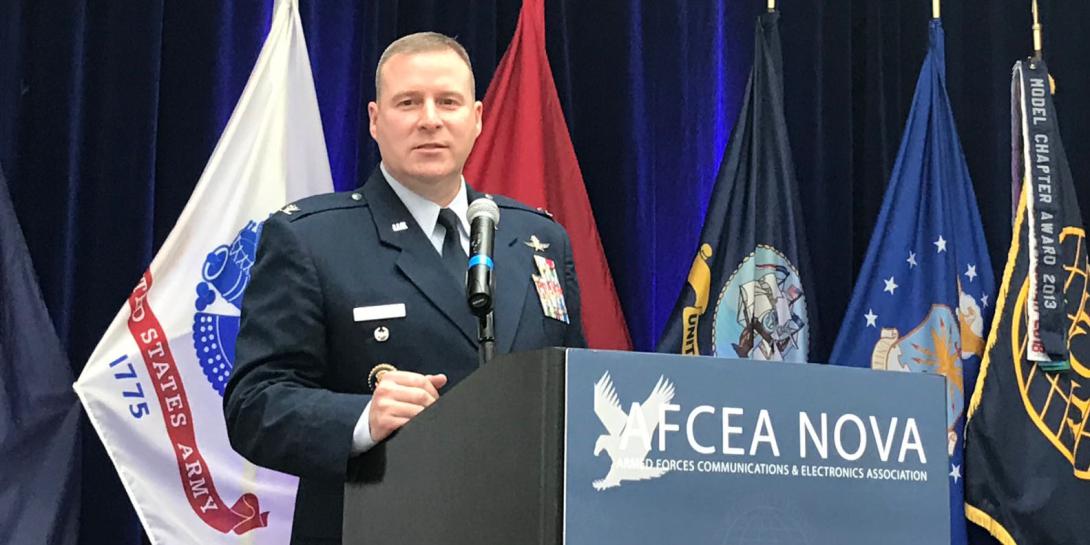The ACC Makes Its Cyber Move
Last year, the Air Force announced it was moving the 24th Air Force, which specializes in cyber operations, and the service’s Cyber Mission from the Air Force Space Command to the Air Combat Command. This spring, the Air Combat Command is working on the merger of those cyber components with its intelligence, surveillance and reconnaissance (ISR) capabilities from the 25th Air Force and integrating cyber into its operations.
The move, which started eight months ago, signifies a shift in the Air Force’s emphasis on putting cyber into everyday operations, said Col. Chad Raduege, USAF, who has been nominated for appointment to brigadier general, director of cyberspace and information dominance, Air Combat Command (ACC).
“There was a realization that we need to get cyber off their plate to allow them to focus on the space realm,” Col. Raduege said. “We have space superiority as a nation right now. And how do we as a nation maintain that? You do that by letting Air Force Space Command do their thing. I think that's reason one why it transitioned [to ACC]. The other reason is the convergence, across DOD, of cyber and intelligence, surveillance and reconnaissance, and how that is fusing together.”
The ACC is now working to integrate cyber effects and cyber operations into its command, including into its conventional forces, Col. Raduege explained at AFCEA NOVA’s recent monthly luncheon in Tysons Corner, Virginia. “The ACC is taking this Cyber Mission very seriously,” he said. “And for the ACC, when we think about cyber, we are taking a whole command approach. There is not just one directorate that is working it. Cyber is integrated across the 3, the 1, 2, 4, 5, 6, 7,” he said, naming the directorates. “Everyone is pulling cyber together at ACC, and we are all pulling in unison.”
As the so-called A-6, Col. Raduege is at the forefront of this cyber integration. “Getting cyber and ISR is going to help us run towards multidomain operations,” he said. He also spoke at the Rocky Mountain Cyberspace Symposium in Colorado Springs in February, outlining the A-6’s efforts within the ACC.
He noted that the A-6 has added two divisions: the “O-Division,” or operations division, specializing in four of the seven cyber weapons systems, as well as combat communications and engineering and installation (ENI). This divisional effort involves a total force community, the colonel said, and relies on guard reserve components.
The A-6 also added a cyber assurance division, putting the ACC in the role as the enterprise authorizing official for the Air Force that determines how things attach, connect and operate on the Air Force Network, or AFNet, Col. Raduege said. This new division will take on risk management framework efforts and employment of the so-called Fast Track Authority to Operate (ATO), which is aimed at drastically reducing the time it takes industry partners to receive cybersecurity approval for information technology systems.
Also coming over from Air Force Space Command to the ACC is the Air Force Network Integration Center (AFNIC)—based at Scott Air Force Base—that specializes in architecture and network design. Officials at AFNIC spent the better part of the last year migrating 55,000 users to the cloud, the colonel noted. The ACC also gained the Cyber Support Squadron, known as CYSS, a legacy organization that takes operator requirements for the cyber weapon systems into the acquisition community, the A-6 leader said.
In addition to those reorganizational changes, the Air Force is shifting its mindset in three key ways, Col. Raduege said. First, the service is moving from being a hardware company to being a software company with hardware components. “Before we'd go out and buy things, and now, instead, we are buying capabilities,” he emphasized. That means “running towards” the enterprise information technology as a service (EITaaS) concept. “In order to move towards multidomain operations we have to have the network that delivers the capabilities that we need,” Col. Raduege said. And we need efficiency gains and the fusion of new technology. We need all of those things that quite frankly that industry does better than we can.”
And for the airmen that had previously handled enterprise information technology, the A-6 noted that they would be put on cyber. “We're going to take the very talented young airmen that we have today, and we are going to transform them into more of defense cyber operators.”
Another shift is to a more targeted approach to cyber defense, and relying on mission defense teams (MDTs). The MDTs will be stationed at a specific base with a particular weapon system and they will build a persistent cybersecurity presence and conduct full functional mission analyses and interact with the operators of those weapon systems to find the best cyber protection. “These MDTs, that persistent cyber security presence, we're going to send them across the entire Air Force and they will tie in very, very well with what we're already doing with Air Force cyber and the existing cyber protection teams,” Col. Raduege stated.





Comments